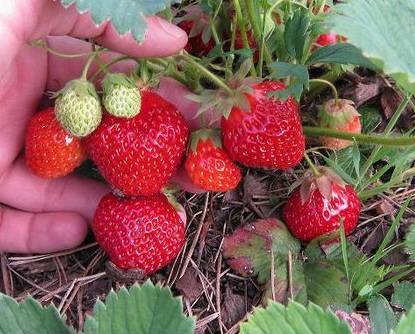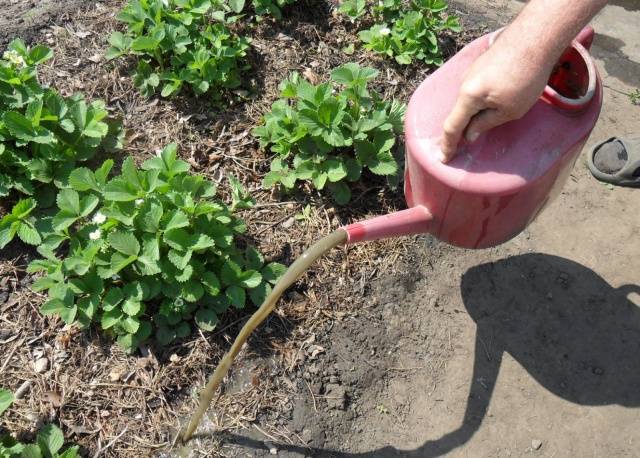Content
Strawberries are found in the garden plots of almost all gardeners. This tasty and juicy berry is liked by both adults and children. However, not everyone knows how to grow it correctly. The yield and size of berries directly depends on the care of the plants. To get good results from your work, you need to know all the secrets of growing strawberries in open ground. In this article we will try to analyze all the intricacies of caring for this plant.
Important Details
It happens that having planted homemade strawberries on your plot, you manage to get a very poor harvest. Sometimes the berries grow small or rotten. The taste of strawberries is not always pleasing either. Instead of juicy and fleshy fruits, they often grow sour and watery ones. But this is not a reason to despair and quit what you started. First of all, you need to learn all the basic technologies for growing strawberries. You need to start with the garden bed and its location. Half the battle depends on the choice of site.
Strawberry bed should not be located in an area that is blown from all sides by winds. In winter, this place should be covered with 20 or 30 cm of snow.Also remember that strawberries will not bear fruit in the shade, so choose an area with good light.
Strawberries will not grow well in a recessed area. Cold air will always accumulate in such a bed, which is why the bushes get sick and produce a very late harvest. On the south side, the snow will melt quickly, and strawberries will remain defenseless against spring frosts. To avoid fungal diseases, strawberries should be replanted to a new location every 2–4 years. Also, you should not thicken the strawberry bushes too much. In this case, the berries will be very small. The best distance between bushes is about 50 cm.
Site preparation
Any type of soil is suitable for growing strawberries. In this regard, strawberries are a rather unpretentious plant. Strawberry is best thrives on black soils. You can also add a little ash to the soil before growing strawberries. It is not recommended to add peat to the soil for growing this plant. Too acidic soils are also not suitable.
Before planting, you need to prepare the soil. This is especially necessary in areas that have not previously been planted with anything. It is necessary to ensure that there are no larvae of cockchafers or wireworms in the soil. These pests can actively destroy bushes in winter. Moreover, one beetle larva can cope with 1 m2 beds.
To make work easier, you can use geotextiles.This modern material will not allow germination weeds, since it does not transmit light. At the same time, geotextiles do not prevent moisture from entering. Many gardeners happily use this material, which saves time and effort.
In spring, the area for planting bushes must be dug up and leveled using a rake. Next, you can add compost to it. Recently, it has become popular to use agrofibre in strawberry beds. It is spread over the surface of the soil, holes are made in the film, and then holes are prepared in them for the bushes. They are watered abundantly with water, and then the seedlings themselves are planted. Agrofibre is one of the best materials for growing various crops. It does not transmit light, so weeds cannot grow, but it allows moisture to pass through perfectly.
Roofing felt can also be used for these purposes. Only now you will have to think about building a drip irrigation system. The hoses must be placed under the roofing felt in the form of a snake. You can purchase special hoses for drip irrigation or make holes yourself (using a gypsy needle or awl). Place a container of water near the garden bed and attach a hose to it. Water frequently soil is not necessary, since roofing felt perfectly retains moisture in the soil.
Choosing strawberries for planting
To obtain a better harvest, you should choose new elite varieties of strawberries. When purchasing bushes, ask whether the seedlings have been sorted and rehabilitated. First of all, pay attention to the root system of strawberries. The root shoots must be at least 7 cm in length, and the root collar must be at least 5–7 cm in diameter.
Some gardeners prepare seedlings themselves. To do this, you need to dig up young bushes in the fall and then place them in a dark, cool place. The bushes can be stored in the cellar until spring. After which, they are planted in the garden according to the scheme described above.
In the spring, before planting strawberries in open ground, you need to take the seedlings to a shaded place and leave them there for 5 days. The hole for planting strawberries should be of such a height that the roots can be located in it freely. The root collar should be level with the ground. If the root system is too long, then it is shortened, leaving about 10 cm.
Agricultural technology for growing strawberries in open ground
Strawberries ripen much faster in beds on the southwest side. A slight slope is allowed. The ideal soil acidity level for growing this berry is from 5.5 to 6.5. It is customary to plant seedlings in the ground in spring or autumn. In this case, you should take into account the temperature outside. You should not plant strawberries too early in spring or too late in autumn so that frost does not damage the grown bushes.
As soon as it gets warmer outside, the film should be removed from the bushes. In the autumn, planting can begin in mid-August and end at the end of September. Before planting seedlings, it is necessary to moisten the soil. You can also plant bushes after rain, while the soil is still quite moist.
When growing strawberries, you need to make sure that the soil does not dry out too much. Regular watering is the key to a good harvest. Some gardeners build a drip irrigation system in their garden.This way you can save time and effort. The system can be fully automated so that it independently supplies water to the site at the appointed time.
It is very important to remove weeds from the garden bed from time to time. In open beds they grow much faster. You will also have to constantly fight pests, which also don’t mind eating strawberries. To prevent the soil from drying out too quickly, you can mulch with humus or straw.
The technology for growing strawberries involves regularly moistening the soil for the first time after planting the bushes. The first week you will have to water the plants every day. Watering should be moderate but regular. Then you can reduce the number of waterings to 1 time every 2 days. Cultivation and care in open ground involves regular weeding and weed removal. It is also necessary to control pests and prevent various diseases as needed.
Fertilizing strawberries
At each stage of growth, strawberries require different fertilizers. For example, during the flowering period, the plant needs potassium. This element contains the following fertilizers:
- potassium magnesia;
- potassium sulfate;
- potassium chloride.
These medications must be used strictly according to the instructions. To increase strawberry yields, foliar cultivation should be carried out feeding strawberries using boric acid. To do this, mix 1 teaspoon of the substance with 10 liters of water in one container. To feed adult bushes, it is customary to use a solution of nitroammophoska. It is also used to fertilize bushes after harvesting.Only in this case the amount of substance in the solution must be doubled.
You can also use organic fertilizers during the flowering period. For example, wood ash or chicken droppings are perfect. And before wintering, you can fertilize the bushes with a urea solution. This will help achieve a better harvest next year.
Pruning and propagation of strawberries
Strawberries propagate in three ways:
- Seeds.
- Young bushes of mustaches.
- Dividing an adult bush.
The easiest and most popular way is to plant seedlings from whiskers. To prepare seedlings for propagation, you need to leave the strongest mustache on the bush. The mustache must be cut off 10–14 days before planting. The mother bush is suitable for growing mustaches for three years.
An important stage of care is trimming leaves from bushes. This allows you to protect the bushes from pests and possible diseases. Use sharp pruning shears for pruning. The procedure can be carried out in the morning, when the dew has subsided, or in the evening. All petioles and stems must be left on the bush. All overgrown leaves and tendrils should be removed. This procedure is very important before wintering strawberries. For the winter, only young and healthy shoots are left on the bushes.
Mulching strawberries
The soil in strawberry beds should be mulched in the fall to protect flower stalks from contact with the ground, and also in the fall to prepare the bushes for winter frosts. Ideal for organic mulch:
- straw;
- manure;
- compost;
- humus.
Inorganic types of mulch include:
- plastic film;
- granite;
- stone;
- mulch paper.
Recently, mulch paper has been in great demand. This material does not contain harmful paints and does not rot.At the same time, it perfectly protects plants from fungi and prevents weeds from germinating. This coating also prevents moisture from evaporating from the ground. Mulch will not only protect the soil from drought, but will also decorate your garden plot.
Strawberry shelter
Not all varieties need shelter for the winter. You should also take into account the climate of your region. In cold, very frosty winters, shelter, of course, will not be superfluous. In warm weather, the covering material is removed so that the strawberries do not rot. Light frosts will not harm the bushes in any way, but, on the contrary, will only harden them.
Conclusion
Strawberry lovers should not be afraid to grow them in open ground. This is an unpretentious plant that bears fruit well in any type of soil. Of course, growing strawberries in open ground requires some effort. Luckily, there are many materials and devices that make the task easier. You could learn some features of growing strawberries in this article. Following these rules, growing strawberries will not be difficult at all. We also invite you to watch a video in which you can see with your own eyes how to grow an excellent crop of strawberries in the country.
















